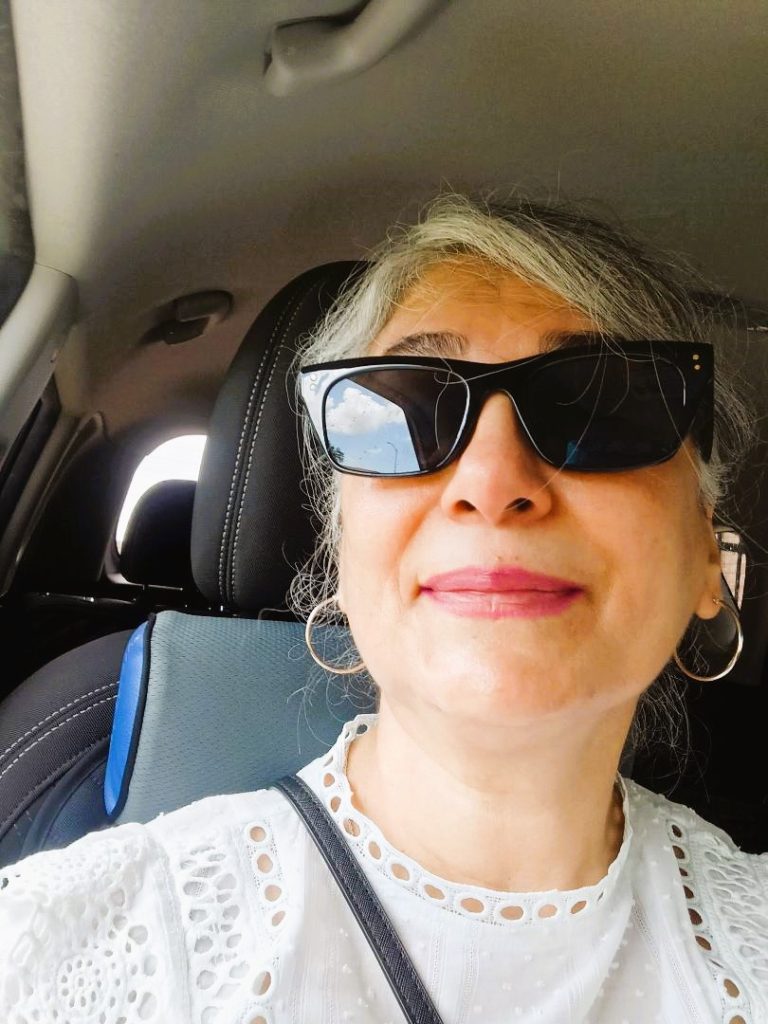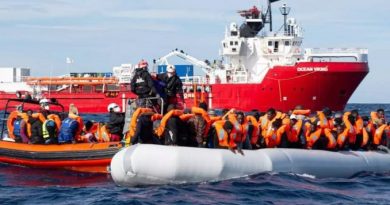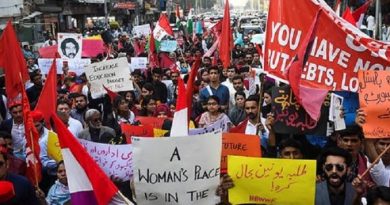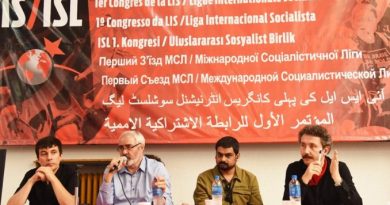rebellion in iran: Interview with Zhaleh Sahand
As the rebellion in Iran continues to unfold, we interview Zhaleh Sahand, an independent Iranian Trotskyist, former political prisoner and retired educator, who now lives abroad, to contribute to our understanding of the process and help build international solidarity. The interview was conducted via email, the following is the response sent by Zhaleh to our questions.

In order to accurately answer your questions, I must point out some thoughts about the state of the current political situation and what the socialists had to face on the battlefield in Iran to achieve the delightful victories that we now possess.
I strongly believe that if the Iranian Islamic regime could go back in time to before it assassinated Mahsa and continue its oppressive existence, they would gladly adopt other tactics to prevent his murder. Mahsa's murder in custody has fueled the most intriguing and ongoing episode of public unrest since we experienced in 2018, in the wave of popular protests across the country and throughout the history of the dissident movement and uprisings in Iran under the Islamic regime.
The unfortunate and unforgettable assassination of Mahsa and the decency of his youth were the most emotional factors in the powerful confrontation of the Iranian people., regardless of age or social status, with the regimen.
The Iranian people's anger at the Islamic regime stems from a long history of oppression, especially for the women of the country. Women have always been treated as second class citizens., with the swords of Damocles hanging over their heads: subject to the most barbaric Sharia laws, violent, despotic and unfriendly in all aspects of their lives; from the lack of control over their bodies to the prejudices they face in the workplace and marriage laws.
I will highlight some specific elements that have contained the steps necessary to bring the brutal Islamic regime to its knees.. with each passing day, people are now getting closer and closer to the goals that we socialists have set for ourselves. These items were:
1-Historically the democratic rights of our women were always overshadowed by general and non-gendered demands for freedom, social openness, economic prosperity and economic equality for all workers, despite what the revolutionary socialists argued in the classics, for women to assume their direct class role in politics.
2-The Iranian labor movement began its opposition to the Iranian regime organically, shortly after the establishment of the regime, no hesitations or interruptions. Nevertheless, the labor movement as a whole has focused its demands mainly on general economic concerns, since the absence of freedom of expression and the extreme use of fascist and oppressive forces by the regime was so brutal, and to ensure for themselves a broader horizon in the fight against the reactionary superstructures in Iran, in the face of the lack of full class consciousness of its lower layers, understanding socialist theories and their ramifications on the objectivity of social realities in Iran, objectively limited their political scope.
3-During years, the colorful and multifaceted movement of Iranian women organized mainly through their own efforts. Our society was still tangled, half strangled, in your own feelings, objective reality and cultural traditions, and struggled to understand and internalize the pain and suffering that gender apartheid and double exploitation brought to women and, ultimately, to the people as a whole.
4-It took time for our people to overcome their difficulties with our cultural traits and to be able to combat their blind spots., its double standards and its dangers for the psychological and socioeconomic well-being of the country as a whole. It took time for the people to fully find the courage to stand up to a reactionary regime to the bone and to go on the offensive against everything that challenges their stronghold..
In this context, the answers to your questions are:
1- The protests that have rocked Iran since the death of Mahsa Amini in police custody continue in force after several weeks. How do you analyze this process?? What are its main characteristics and where is it now??
As Engels explains, on the research, the principles are the final results and not what we started with. Principles can only be affirmed on one condition; if they confirm the objective world as it is. So, now we are seeing that our women's movement is ready to take its task to higher stages. So that our women as a force, in a society marked by diverse cultural aspirations, political and economic, could assume their historic tasks and radicalize our movement, they had to find their own place and their own tasks, not simply accept what was chosen for them. they are in a better place, And they won't back an inch from what's theirs now.
Apriorism is not and never was a response to a radical movement. People are on the streets of Iran right now because our women have shown that they can firmly defend themselves in practice.. The socialist movement in Iran needed to see that our women can fight for themselves, with the men supporting them by their side. Our working class and radical movement are now seeing the political power projected by our women and men on full display.. This is a turning point in the history of our dissident movement., that makes present realities different from our past experiences.
The characteristics of our movement at this stage are:
1-A close partnership is developing organically between our men and women, seeing each other not as separate entities with different needs, but as partners in their mutual aspirations, partners in their political investments, and partners in the process of fully understanding the Islamic regime's sexual apartheid attempting to stifle our women's pursuit of freedom and equality.
2-Students and young people under 30 years are the 60 percent of Iran's total population of 86.456.245. These students and young, women and men, are a driving force behind the current movement, as in all previous smaller-scale protests. Other age groups are still hesitant to join the protests in large numbers, due to the security risks involved. Nevertheless, there is no doubt that they are in spirit with their sons and daughters on the streets of Iran and politically they are their silent partners.
3-These students come from diverse classes and strata, they are mostly sons and daughters of the working class. in your aspirations, Nevertheless, a desire for justice and the establishment of a democratic republic is clearly manifested.
4-Elementary and secondary school students were never an organic part of the student protests that took place in Iran before. Now, they go on strike at their schools when possible, join the protests in the streets and are developing an inseparable partnership with adult college students as the days go by. The movement has faced the assassination of 32 schoolchildren, brutally shot by Iranian security thugs in different cities since the start of the protests.
5-The slogans chanted in the protests that are formulated in a conscious and precise way, have radical overtones and target both the deposed royal family (that he has some supporters in Iran and wants the monarchy back) as well as the Islamic regime as a whole. The slogans are directed against the entire system and not just the mandatory hijab, which is just one element of the whole picture, seeks regime change from below.
6-The protests look autonomous, with radical slogans. They are taking place spontaneously in different streets and neighborhoods instead of concentrating in specific centralized places like before.
7-Protests are taking place every day, with people taking to the streets on a larger scale some days and on a smaller scale other days, to recover. The protests seem fluid and moving and, as all the evidence suggests, unstoppable. They can be offensive or defensive, according to the situation and the scale of violence of the regime.
2 – In the last decade there have been several cycles of protest and mobilization in Iran. Are there elements of continuity between these processes and the current? Is there something different now?
The dissident movement in Iran from its first day was a movement of the working class. He fought to establish independent unions, he was fighting inflation, against falling real wages, to obtain permanent employment contracts instead of temporary ones, fought back wages, fought against lack of job security and to reinstate workers fired simply for expressing concerns or having union affiliations.
Since the year following the revolution of 1979, the element of continuity in the protests that have taken place focuses on the deprivation of all rights and the stark political oppression inflicted on our society. This oppression points to other layers of our society with better economic conditions., but without freedom of expression, press and meeting as a whole. This makes them partners of the working class in our political uprisings..
Besides all this, our women who suffer from a double standard as a result of the sexualization of their civil rights are forced to do more to fight against the gender apartheid system of the Islamic regime. This system is strangling them with a lack of freedom of choice, the compulsory Hijab and reactionary sharia laws to the bone that have put our women's lives in agony for 44 years.
What makes the current phase of our movement different from the previous one is the radicalization of the slogans chanted in the streets, targeting the entire system, and not to a part of it. Subjective need is finding its own way to connect with the objective economic miseries faced by the Iranian population as a whole.. this is a marriage, a prerequisite for the radicalization of any movement that has as its perspective a socialist or at least a democratic revolution. What is new now is that our women are not on the defensive but on the offensive, showing that they are ready to fight tooth and nail for their rights.
3-We have seen the brutal repression deployed by the regime. What other strategies have you adopted to try to stop the protests??
Although our movement today appears to be autonomous and leaderless, their slogans are very controlled, which suggests that it is leading towards some kind of organization from within. According to an internal action plan that was released at the start of the protests a few 4 weeks, one of the tactics that the Islamic regime developed was to bring down the protests from within, sending their plainclothes agents to join the protests to change the nature of the slogans and thus discredit the integrity of the movement. These regime agents would chant slogans in support of the deposed royal family (who has some supporters in Iran, but he will never be able to turn back the clock or have even the slightest chance of playing a role in the future of Iranian politics.). Their goal was to cause fractures in the solidity of the protesters' righteous rage and prevent radicals from joining the protests in large numbers..
That tactic has failed, and we have not seen in the slightest any chants of support for the monarchy in the protests that have taken place for a long time 4 weeks. In fact, one of the most chanted slogans on the streets of Iran is "No to the dictator, either king, mullah the leader, i.e. Khamenei).
The other tactic adopted by the regime was to try to find ways to focus the protests in a small number of places.. This would allow them to systematically suppress a protest easily by sending their security goons to designated streets.. That tactic also backfired., since our protests are now taking place in different places and neighborhoods, contributing to the confusion, exhaustion and disorganization of the regime.
The regime is both on the offensive and defensive right now, but can't kill the move as easily as before. This time our people have more confidence in the power of their collective determination and in our women as the dynamic engine of the movement.
As Marx indicated, “the position of women in society could be used as a measure of the development of society as a whole”. The movement not only targets the fascist superstructure of the regime, but to all its entity, singing "The target is the system itself, and this is the last message”. The Islamic regime is fully aware of these burning sentiments; this is a defining moment for us, socialists, let us inject greater doses of slogans and radical demands and, as our next step, We demand the creation of local councils and workers.
4-What social and political forces intervene in the movement? What role does the working class and its organizations have?? Have organizations emerged to coordinate the fight? What organized forces of the socialist left are there??
Our movement is very diverse. Iran, with a poblation of 86.456.245 To the date, home to seven ethnic minorities that are among the most marginalized and exploited populations: kurds, arabs, baloch and others. The presence of political oppression, economic devastation and poverty has always had an uglier face in the provinces of these ethnic minorities, both in the regime of the Shah and in the Islamic. It is, the most disadvantaged working masses, they have always been the backbone of our dissident movement of the working class in Iran. The demonstrators chanted "Turks, kurds, arabs, During, they are together".
Together with our ethnic minorities, the popular movement includes the different classes of people and strata of Iran with their different political aspirations and for their movement. Nevertheless, It is mostly led by the sons and daughters of our working masses and is inspired and hegemonized by those worker ideals as its centralized motors., strength with a thought, a more coherent claim and consistency.
our petite bourgeoisie, as usual, has its own inconsistencies, political doubts and hesitations about what they yearn for, in all world revolutions for democracy and socialism, have always exhibited these characteristics. Nevertheless, their inconsistencies do not prevent them from joining our movement, and they do and they have been in the mobilizations in the streets of Iran. The petty bourgeoisie knows that they cannot sit idly by for long and they know that they will also be crushed by capitalism if they do not assume their responsibilities for a better future..
I strongly believe that the protesters are mostly daughters and sons of our working class in the streets of Iran. This is very different from what we see in protests taking place abroad., where some carry the loyalist flags (of the Shah) in hand and must be outnumbered by the active presence of socialists throughout the world.
Since the year following the revolution of 1979, the regular presence of our working class on the streets of Iran, some class conscious and the rest more or less carrying out class driven conscious demands, has been the guiding force behind all the protests that have occurred. This has shown us the balance of power needed to move forward..
The working class and its unions have always issued statements of solidarity, in support of the protests that have been carried out by different groups of people and have supported them as individuals in acts of solidarity.
The key to winning the overthrow of any despotic capitalist regime, including the Islamic regime in our case, is in the hands of our working class. Teacher strikes in Iran have always played a vital role in our movements with their radical demands and protests as well.. The workers' unions began the strike two weeks ago. if they go further, that can unbalance the Islamic regime and bring it to its knees, coming close to destabilizing its foundations with the great power of the workers.
We all know that the working class, with all your might and strikes, Join the revolutionary movements, when the objective manifestations and mental disposition of the population and the movement to destroy the capitalist system are ready. The working class dedicates all its strength to a phenomenon that can guarantee the destruction of capitalism.
With this in mind, and amid the arrests of hundreds of workers, our petrochemical workers in Asalouyeh, in the oil-rich southern province of Bushehr, and at the Abadan refinery they have been on strike since last Monday 10 October. He 18 October, the Haft Tappeh Sugar Mill Labor Union announced that its workers had also joined the strikes; have urged other unions and workers to join the strikes.
Abadan fuel tanker drivers began their strike on 19 October. Workers at various stages of the South Pars gas and condensate field, Bushehr Petrochemical Company y Hengam Petrochemical Company, operating in the Asalouyeh compound, the Abadan refinery and petrochemical company, Mahshahr's Refinery and Pipe Mill Plant, as well as the Neyriz Ghadir Steel Complex on the shores of the Persian Gulf have been on strike in solidarity with protests across Iran.
The organizing council of contracted oil workers issued its second statement, giving an ultimatum that if his arrested colleagues are not released immediately and if the regime's repressive special forces are not withdrawn from his workplace, they will expand their protests and they will not remain silent.
The protests expand and new cities join as the days go by. socialists, although they must remain in hiding, they stand shoulder to shoulder with people across the country. The need to establish a socialist organization for the leadership is very essential at this time., but our vanguards come from different traditions and schools of thought. To systematically lead the movement for socialism, they must find the most suitable militant platform for the formation of an opposition and revolutionary organization. A group of socialist workers recently announced its existence in Khuzestan.
5-What possible political scenarios do you see for the coming weeks and months?? What tasks do you think the revolutionary left has?
Our women are finding their own independent voices and know that without them, no revolution will take place anywhere. We must also understand: «Altering the position of women at the root is only possible if all the conditions of social existence are altered, family and domestic». (Trotsky, Women and the Family, p. 45.) Thus, our women need to take seriously that a change in their position will only happen, not in a bourgeois democratic revolution, but in a simple socialist revolution, shapely and anti-authoritarian. That is what your efforts should aim at..
It is impossible to make any forecast of what will happen in the coming weeks and months. As Lenin wrote: "A revolution is impossible without a revolutionary situation; Besides, not all revolutionary situations lead to revolution. Which are, in general, the symptoms of a revolutionary situation? Certainly we will not be wrong if we indicate the following three main symptoms: (1) when it is impossible for the ruling classes to maintain their rule without any change; when there is a crisis, one way or another, among the "upper classes", a crisis in ruling class politics, that leads to a fissure through which the discontent and indignation of the oppressed classes explodes. For a revolution to happen, it is usually insufficient that "the lower classes do not want" to live in the old way; it is also necessary that “the upper classes be incapable” of living in the old way; (2) when the suffering and misery of the oppressed classes have become more acute than usual; (3) when, as a consequence of the above causes, there is a considerable increase in the activity of the masses, who without complaining allow themselves to be robbed in "peacetime", but, in turbulent times, they are attracted both by all the circumstances of the crisis and by the “upper classes” themselves in an independent historical action”.
So, with all that Lenin has said, We must precisely try to delve into the three decisive and determining factors in order to overthrow the regime. with all the evidence, I firmly believe that we will approach these three indicators if our masses begin to overcome their fears., to believe in themselves and in their devastating power, and to demonstrate it to the regime with its active presence in the streets of each city. The regime has already begun to split from within over its policies, and will only stop the killings when the people demonstrate in the streets by the millions.
If for lack of any of the three required factors, the masses are forced to go back to better fulfill their tasks in other phases, then they will still have achieved some of their essential goals at this point, even if they have to go back to rejuvenate their tactics. Those goals were:
1-People were able to radicalize their movement and leak their demands, bringing to the streets of Iran the most militant and class-conscious masses, as far as possible.
2-People were able to estimate the power of the regime by confronting them and estimate the growing power of the radicals and the masses, by organizing spontaneously or with a clandestine organization as leadership.
3-People were able to raise their voices much louder and get the attention of the international left and the communists, to finally attract their support. (Although we always had, during 44 years, most international workers unions supporting us in spirit, without condescension). Those who unfortunately remained idle for years, his lack of support for the socialist movement in Iran, regardless of your intentions- contributed to the interests of the capitalist mullahs and gave the green light to the relentless and savage oppression of our dissidents by the Islamic regime.
6-What can we do internationally to show solidarity and support the struggle of the Iranian people?
iranian students, who mostly come from the working class, the workers and the workers themselves have shown once again that they have all the powerful forces, the dignity and political determination to inspire the remaining layers of our society to join them in the ouster of Iran's despotic regime, when the time comes to determine your own political destiny.
What we want is that all the imperialists, small or big, hands off iran. That means the United States and its British counterpart, for all the most notorious crimes they committed against the oppressed peoples of the world, less well known is his notorious support for the Shah; the overthrow of the democratic government of Prime Minister Mohammad Mosaddeq, its covert operations and ongoing sanctions against the people of Iran. That also includes the polar opposite, Russia and China, that have fueled capitalist Iran and its repressive machinery for years.
It is the duty of all progressive forces and global labor organizations to defend the genuine aspirations of the labor movement in Iran and to oppose the destructive interference of powerful capitalist governments throughout the world and in the region.. The tireless struggles of the working class in Iran and the region will only flourish with broad and organic international solidarity..
We want the support of politically fair people in the world, leftists and socialists, to help us bring genuine socialism from below to Iran. we want, in the spirit of international solidarity, that international socialists consistently side with us, inject blood into our movement and help the movement find its defined revolutionary traits.
Genuine anti-imperialists must not side with the hypocritical and bloodthirsty Islamic regime, but ours. This is the only genuine anti-imperialism that will make possible the workers' revolution in Iran. This is the only way to build a bridge with us, and with the masses around the world and in the politically turbulent Middle East.




